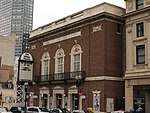Shubert Theatre (Boston)

The Shubert Theatre is a theatre in Boston, Massachusetts, at 263-265 Tremont Street in the Boston Theater District. It opened on January 24, 1910, with a production of Shakespeare's The Taming of the Shrew starring E. H. Sothern and Julia Marlowe. Architect Thomas M. James (Hill, James, & Whitaker) designed the building, which seats approximately 1,600 people. Originally conceived as The Lyric Theatre by developer Charles H. Bond, it was taken over by The Shubert Organization in 1908 after Bond's death.The building was added to the National Register of Historic Places in 1980. In February 1996, the Wang Center signed a 40-year lease agreement to operate the theatre with the Shubert Organization, which continues to own the building and property; the theatre reopened after renovation in November 1996. The Boch family became the namesake of the center in 2016, making the full name of the theatre the Shubert Theatre at the Boch Center.
Excerpt from the Wikipedia article Shubert Theatre (Boston) (License: CC BY-SA 3.0, Authors, Images).Shubert Theatre (Boston)
Tremont Street, Boston
Geographical coordinates (GPS) Address External links Nearby Places Show on map
Geographical coordinates (GPS)
| Latitude | Longitude |
|---|---|
| N 42.3504 ° | E -71.0654 ° |
Address
Shubert Theatre
Tremont Street 263;265
02111 Boston
Massachusetts, United States
Open on Google Maps






